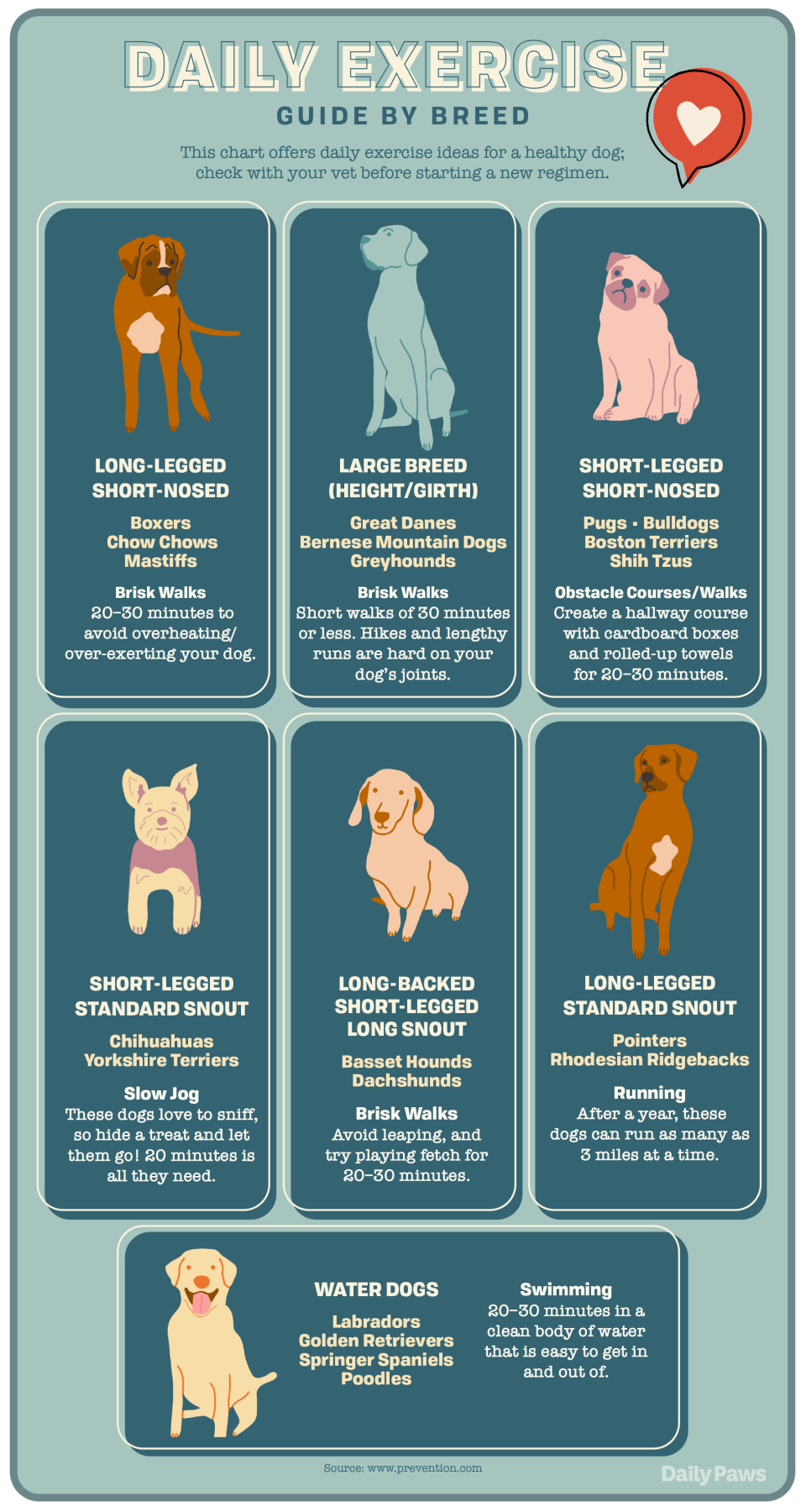How Much Exercise Does a Dog Need?

Grace Canaan
TABLE OF CONTENTS
On This Page
Factors That Influence How Much Exercise a Dog Needs
How to Know If Your Dog Is Getting Enough Exercise
As a dog parent, you wear a lot of hats. You're a kibble connoisseur, a fur stylist, a bark translator–and you even fill a role that involves carrying around a tiny roll of poop bags everywhere you go. But there's one hat that doesn't always get the attention it deserves: your role as a personal pup trainer.
Exercising your dog seems like it would be a straightforward endeavor, like walking him twice a day to keep the zoomies at bay. However, you've probably noticed that dogs are wildly and wonderfully unique across a wide range of variables. And as such, the best exercise plan for your dog will take into account his age, his breed, and his health status.
There's no simple answer to the question of how much exercise your dog needs to maintain his physical and mental health. A veterinarian who knows your dog and his history is in the best position to help you develop an exercise plan, but Kim Krug, DVM, veterinary behavior resident at Animal Behavior Clinic in Portland, Ore., is here to share some of the top considerations.
4 Factors That Influence How Much Exercise a Dog Needs
If you've ever been around a lumbering Newfoundland and a zippy border collie, or a playful puppy and mellow senior dog, it won't come as a surprise that some dogs need more exercise than others. How much exercise your dog needs and the types of activities he will enjoy depend on four main factors: his age, breed, health status, and personality.
1. Age
According to Krug, puppies likely need several short, 10- to 15-minute bursts of activity (e.g. exercise, enrichment, training) throughout the day. However, she adds that repetitive, high-impact exercise (including fetch and long-distance running) isn't recommended in young dogs before their bones and joints are fully developed, which happens between 12 and 24 months, depending on the breed.
Krug says that in general, as puppies get older, they need longer activity times but that the frequency will decrease. "Adolescence, which spans from about 1 to 3 years of age, is when most dogs experience their highest exercise needs," she continues, "but this can obviously vary significantly by breed."
After this peak in adolescence, your dog's exercise needs will slowly decrease, but it's still important for adult and even senior dogs to get adequate mental and physical stimulation. Low-impact exercise like daily neighborhood walks are a great way to help keep a senior dog's brain and body active and healthy.
2. Breed
"Researching and understanding your dog's specific breed and corresponding traits is the best way to ensure you're meeting his inherent exercise and enrichment needs," Krug says. "For example, a sighthound is likely to need exercise that involves running and sprinting. A hunting breed is likely to benefit from sniffing and following their nose. A Labrador may be more likely to want to play with other dogs versus a border collie who may prefer walking as a group but not directly engaging with the other dogs." Similarly, some dogs are more content to spend their days lounging on laps (e.g. shih tzu, bichon frise, French bulldog), while others are far happier living as hiking, biking, and running companions (e.g. Airedale terrier, golden retriever, Australian shepherd).

Illustrations / Caitlin-Marie Miner Ong
3. Health
Krug notes that underlying medical conditions (especially orthopedic disease) impact what type of exercise plan is recommended, so it's important to check with your veterinarian if you're uncertain about letting your dog try a new activity. Breed can also come into play in this category, as some breeds are predisposed to certain medical conditions. For example, brachycephalic breeds (i.e. dogs with short muzzles and flat faces like boxers, bulldogs, and pugs) are prone to overheating. Long bouts of intense exercise—especially in hot and humid weather—are not recommended for these dogs.
4. Personality
"Obviously, there can be a lot of individual traits in a dog that change what type of exercise they prefer so there isn't a perfect formula," Krug explains. "We have to critically evaluate this for each individual dog." That means a lazy Cavalier King Charles spaniel who likes to lounge around on the couch with you won't want to exercise as much as a border collie who regularly participates in sports like flyball or agility.
How to Know If Your Dog Is Getting Enough Exercise
There may not be a perfect formula for determining how much and what kind of exercise would best benefit your dog, but there are signs your dog is getting either too little or too much exercise.
Signs Your Dog Needs More Exercise
According to Krug, inadequate exercise can manifest in the following ways:
Hyperactivity outside of exercise times
Destructive behaviors (e.g. chewing)
Attention-seeking behaviors (e.g. excessive barking)
Trouble settling
Little to no deep sleep (signs include muscle twitches, vocalizations, not staying asleep through soft noise and movements)
While the causes behind a dog's weight are multifactorial, an overweight or obese dog would likely benefit from more exercise as part of a comprehensive weight-loss plan under a veterinarian's supervision.
RELATED: How Often Do You Walk Your Dog? See If You're Walking Your Pup Enough
Signs Your Dog Is Getting Too Much Exercise
Despite having seemingly insatiable stores of energy, dogs can get too much exercise. "If your dog is engaging in high-intensity exercise (e.g. competitive sports dogs, distance running, long hikes with elevation), like human athletes, they need rest and time for their body to recover," she explains. "Keep in mind that if we would take a recovery day following an activity, our dogs would likely benefit from a recovery day as well."
Krug says that if your dog displays the following changes either during exercise or following rest after exercise, it may be a sign he's engaging in inappropriate or too much exercise. It may be also indicate that he has an underlying medical condition:
Heavy panting or wheezing
Limping or lameness
Stiffness
Changes in gait
Hesitation when rising or lying down
Avoidance of jumping or moving a certain way
Irritability
Avoidance of touch
Atypical aggression toward other animals or humans
"Listen to your dog," Krug says. "If your dog normally gets excited when you say 'walk' or when you pick up the leash and then after three walks in one day he isn't excited or doesn't come to the door when you pick up the leash, he's saying 'no thanks.'"

